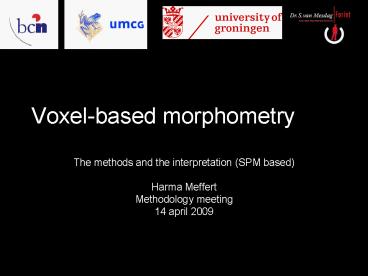Voxel-based morphometry - PowerPoint PPT Presentation
1 / 26
Title:
Voxel-based morphometry
Description:
A voxel-based morphometric study of ageing in 465 normal adult human brains. ... Voxel-based morphometry of the human brain: Methods and applications. ... – PowerPoint PPT presentation
Number of Views:418
Avg rating:3.0/5.0
Title: Voxel-based morphometry
1
Voxel-based morphometry
- The methods and the interpretation (SPM based)
- Harma Meffert
- Methodology meeting
- 14 april 2009
2
Outline
- General preprocessing steps
- Preprocessing
- Comparison two recent tools
- Data analysis
- Discussion about ISSUES
3
General preprocessing steps
4
VBM
General preprocessing steps
5
VBM
Normalisation step a closer look
- Determine parameters
6
VBM
Normalisation step a closer look
- Determine parameters
- Deform brain to fit template
7
VBM
Normalisation step a closer look
- Determine parameters
- Deform brain to fit template
- Unmodulated (concentration)
- Modulated (volumetric)
8
Preprocessing
- Protocols and toolboxes
9
Overview toolboxes and protocols
- Standard VBM SPM99 / SPM2
- Optimised VBM SPM99 / SPM2
- VBM with unified segmentation SPM5
- VBM2 toolbox for SPM2
- VBM5 toolbox for SPM5
- Dartell
10
Standard VBM SPM99 / SPM2
Normalisation
Segmentation
Gray matter
White matter
modulation
modulation
smoothing
smoothing
Analysis
Analysis
Mechelli et al. 2005
11
Optimised VBM SPM99 / SPM2
Segmentation
Gray matter
White matter
Normalisation to GM template
Normalisation to WM template
Apply norm. par. to raw image
Apply norm. par. to raw image
modulation
modulation
smoothing
smoothing
Analysis
Analysis
Mechelli et al. 2005
12
VBM with unified segmentation SPM5
Tissue classification, image registration and
bias correction within one model
13
VBM5 toolbox in SPM5
MRF prior probability
Noise reduction with Markov Random Field
14
Summary Segmentation and Normalisation
- Options and considerations
- Normalisation before segmentation
- Optimized order (norm ? segm ? norm)
- Unified segmentation (SPM5)
- Unified segmentation with the use of customized
priors (VBM5) - Unified segmentation without the use of priors
for tissue classification (VBM5) - Hidden Markov Random Field (VBM5)
- Center of mass as origin doesnt work
15
Summary Modulation
- Options, considerations and questions
- Unmodulated concentration
- Modulated volume
- Modulation of
- non-linear effects only
- affine and non-linear effects (no correction for
brain size afterwards) - Smoothing
- Less smoothing in modulated images
16
Comparison two recent tools
17
VBM5 vs SPM5
18
Data analysis
19
Data-analysis Considerations
- Corrections for multiple comparisons with local
maxima of the t statistic - GLM with SPM, SnPM, machine learning algorithms
- Global or localized inferences? Use of covariates
- Non-stationary cluster extent correction
20
Voxel-based morphometry
- The Issues!
21
Issue 1 Unmodulated images
- Compatible with modulated images?
- Just registration errors?
- Very dependend on used toolbox?
- Normalisation proces Adding or removing voxels
how does that happen?
22
Issue 2 Covariates
- If you modulate for both affine and non-linear
effects you do not have to correct for global
brain size. - If global brain size is correlated with
treatment it is not a good covariate because it
will mask treatment effects
23
Issue 3 What do the tissue labels mean
- If you add up probabilities in one voxel across
different tissue types they can be gt1 - Could you use white and gray maps to determine
the relative amount of gray for example
24
Issue 4 How do you assess the quality of
segmentation
- VBM5 has the option to chack sample homogeneity
- Furthermore it is visual inspection
25
Literature
- Ashburner, J. and K. J. Friston (2000).
"Voxel-based morphometry--the methods."
Neuroimage 11(6 Pt 1) 805-21. - Ashburner, J. and K. J. Friston (2001). "Why
voxel-based morphometry should be used."
Neuroimage 14(6) 1238-43. - Ashburner, J. and K. J. Friston (2005). "Unified
segmentation." Neuroimage 26(3) 839-51. - Bookstein, F. L. (2001). ""Voxel-based
morphometry" should not be used with imperfectly
registered images." Neuroimage 14(6) 1454-62. - Devlin, J. T. and R. A. Poldrack (2007). "In
praise of tedious anatomy." Neuroimage 37(4)
1033-41 discussion 1050-8. - Good, C. D., I. S. Johnsrude, et al. (2001). "A
voxel-based morphometric study of ageing in 465
normal adult human brains." Neuroimage 14(1 Pt
1) 21-36. - Mechelli, A., C. J. Price, et al. (2005).
"Voxel-based morphometry of the human brain
Methods and applications." Current Medical
Imaging Reviews 1(2) 105-113. - Ridgway, G. R., S. M. Henley, et al. (2008). "Ten
simple rules for reporting voxel-based
morphometry studies." Neuroimage 40(4) 1429-35. - Ridgway, G. R., R. Omar, et al. (2009). "Issues
with threshold masking in voxel-based morphometry
of atrophied brains." Neuroimage 44(1) 99-111.
26
- NeuroImaging Center Social Brain lab
- Prof. Dr. Christian Keysers
- Dr. Valeria Gazzola
- MSc. Jojanneke Bastiaansen
- Other members of the lab
- Department of Psychiatry, UMCG
- Prof. Dr. Hans den Boer
- FPC Dr. S. van Mesdag
- Dr. Arnold Bartels
- Dr. Marinus Spreen
- Research department































